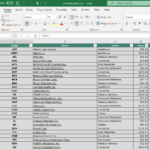This article/post contains references to products or services from one or more of our advertisers or partners. We may receive compensation when you click on links to those products or services
If you’re interested in taking control of your money, an excellent starting place is to look at your income. You can divide your paycheck every month to prioritize your goals. This is a method of money management called “paying yourself first” (or PYF). It’s used by thousands of Americans to pay down debt, save money, and reach their financial goals.
Paying yourself first is a budgeting strategy that helps ensure you reach your financial goals by putting money aside from each paycheck and using what’s left for your daily life and leisure expenses. This method ensures that you meet your financial goals and carve out some fun money — an essential part of making a budget that you can stick to.
That said, there’s no one-size-fits-all budgeting method that works for everyone, and that’s true of this one. Business owners with variable incomes, for example, might find it challenging to put money into savings during lower earning months and might not think of upping their savings during higher earning months.
If you’re interested in this tried and true method to divide your paycheck, keep reading to find out everything you need to know about paying yourself first.
The Short Version
- Paying yourself first is a budgeting method that focuses on prioritizing savings goals through automation.
- There are several ways to pay yourself first, including splitting your money 80/20 or 50/30/20.
- Setting up a pay-yourself-first budget includes automating your paycheck to be deposited into your online brokerage or savings accounts.
How the Pay Yourself First Budget Works
The PYF budget involves dividing up your paycheck as soon as you receive it and sending a portion of that money toward your financial goals (like saving for a down payment or paying off debt) and then divvying up the rest for needs and wants. There are two primary ways to divide your paycheck using the PYF method.
80/20 Budget
Budgeters who use the 80/20 rule save 20% of their paycheck for financial goals like retirement, debt repayment, or building an emergency fund and the remaining 80% of their paycheck for expenses like transportation, rent, groceries, and entertainment.
The 80/20 method of paying yourself first is a flexible and ideal strategy for first-time budgeters or those who want to save but also hope to devote large portions of their income to paying off debt.
50/30/20 Budget
While the 80/20 method of budgeting ensures you save at least 20% of your paycheck, you can divide your paycheck further using the 50/30/20 method to make sure your budget is even more balanced.
Using this method, you’ll divide your paycheck using the following percentages:
- 50% on needs (like paying your mortgage and groceries)
- 30% on wants (like travel and eating out)
- 20% on savings (like emergency or retirement savings)
The 50/30/20 method is ideal for busy households because it prevents you from spending too much on your “wants” and ensures you have enough money allocated toward your “needs.”
Alternatively, the 50/30/20 rule can help you gain insight on and avoid future financial obligations where you might be spending too much on your “needs.” For example, by simply running the numbers, you may decide against taking on a mortgage that is too large, or a car payment that you can’t afford.
The 50/30/20 method of dividing your paycheck is a good choice for young families who may incur debt like car payments and mortgages and want to ensure they aren’t overspending on needs.
Related>>How Can Emotions Affect Your Investing Decisions?
Benefits of Paying Yourself First
No matter how you slice it, there are numerous benefits to the PYF method of budgeting. First, an issue that most investors face is making sure they’re investing consistently. When you pay yourself first, you guarantee that you will build a nest egg over time.
Paying yourself first will get your money where it needs to go as soon as you get your paycheck, instead of waiting to see what is left over at the end of each month. That way, you are guaranteed to save money each month — and over time, that money will snowball into a significant amount.
Second, paying yourself first is easy. By setting up automatic deposits to your investment brokerage and savings accounts, paying yourself first takes no effort on a month-to-month basis. As long as your paycheck is deposited at predictable intervals, you can set up an automatic withdrawal from one account into your savings or investment accounts.
Finally, this method is adaptable. Once you master it, you can use the strategy to suit whatever your next milestones happen to be. Whether it’s paying off debt, early retirement, or buying your dream home, you’ll make sure you get it done by paying yourself first.
How to Build a Pay Yourself First Budget
While the theory of the PYF budget is sound, and thousands of people have used it to achieve their financial goals, it may be hard to see how you can incorporate it into your own life. How do you set about using this method to budget your money? Here’s precisely how it works.
First, decide whether you want to use the 80/20 method or the 50/30/20 method. Remember:
80/20: 80% of your paycheck goes towards needs and wants, and 20% goes towards savings.
50/30/20: 50% of your paycheck goes towards your needs, 30% to your wants, and 20% to savings.
What an 80/20 Budget Looks Like
Using the 80/20 method starts with designating 20% of your income towards financial goals. You can divide up that 20% however you’d like. For example, you might allocate 15% of your paycheck toward retirement savings and 5% toward building your emergency fund.
That means if you receive a bimonthly paycheck of $2,500, you can expect to allocate:
- $2,500 x 15% = $375 for retirement savings
- $2,500 x 5% = $125 toward emergency fund
Once you have that money allocated, you can comfortably spend the remaining 80% (in this case, $2,000) on your wants and needs, at your discretion.
To put this budget into practice, you’ll need to set up an automatic contribution to both your retirement savings and your emergency fund. That way when your paycheck hits your account, your savings are removed automatically from your checking account. The rest is yours to spend.
What a 50/30/20 Budget Looks Like
Choosing the 50/30/20 method for dividing your paycheck is slightly more involved but still very straightforward.
Using the example above, if you receive a bimonthly paycheck of $2,500, your allocations will be as follows:
- Savings: $2,500 x 20% = $500
- Needs: $2,500 x 50% = $1,250
- Wants: $2,500 x 30% = $750
Again, you can save on autopilot by setting up automatic transfers from your checking to your savings or brokerage accounts. To ensure your needs and wants are in balance, you’ll need to tally up your spending and determine which are needs and wants.
Needs include:
- Car payments
- Car insurance and maintenance
- Gasoline and transit passes
- Cell phone bills
- Rent and mortgage payments
- Groceries
- Insurance
- Utilities
Wants include:
- Entertainment
- Subscription streaming services
- Gym memberships
- Shopping
If you add up your expenses and your spending and find that your wants and needs aren’t in balance with the 30/50 division suggested, you can alter your budget to bring it into balance.
The Bottom Line
A prosperous financial future isn’t about picking the right stocks or riding a cryptocurrency all the way to the moon. While these aspects of financial management may help you grow your net worth, it’s way more important to have solid fundamentals.
You can’t get much more basic than establishing a solid savings routine by paying yourself first. Paying yourself first or dividing your paycheck lets you start saving in a pain-free way. There are plenty of other ways to budget, from zero-based budgeting to the envelope method. Still, this is a super-flexible strategy that prioritizes your financial goals, while giving you lots of breathing room.
Now that’s what we call a win-win.
More budgeting basics>>













